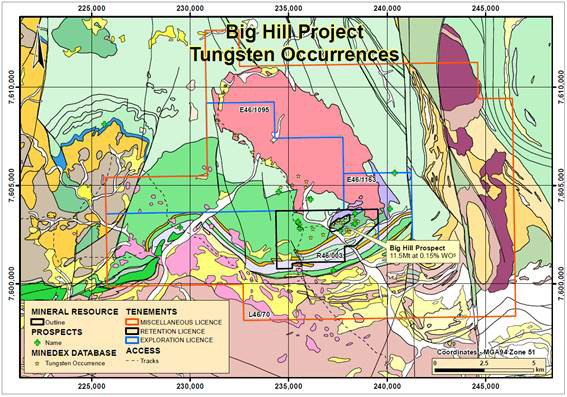Cookes Creek
The Cookes Creek area is made up of two granted exploration licenses (E46/1095 and E46/1163) about 85km south east of Marble Bar in the East Pilbara of Western Australia that cover an area of 51km2. The tenement area contains a number of recorded tungsten, molybdenum and base metal occurrences and adjoins Tungsten Mining NL’s (ASX: TGN) Big Hill Project which contains a JORC 2012 Mineral Resource of 11.5Mt at 0.15% WO3 (Indicated Resource of 6.2Mt at 0.16% WO3 and Inferred Resource of 5.3MT at 0.13% WO3) (refer to TGN ASX announcement Big Hill Mineral Resource Update 22nd June 2016).
Geology
The Cookes Creek project area (Figure 1) is located within the Pilbara Craton, on the margin of the East Pilbara Terrane and Soanesville Basin. The Pilbara Craton has an exposed area of over 180,000 km2 and comprises Archean granite–greenstone successions intruded by granitoids complexes (northern Pilbara Craton), in addition to the unconformably overlying Neoarchaean to Paleoproterozoic volcanic and sedimentary units of the Hamersley Basin, which dominate the southern Pilbara Craton and form outliers in the northern Pilbara Craton.
The Cookes Creek project area is a well-preserved and well-exposed granite-greenstone belt, including granites and enveloping volcano-sedimentary rocks. It is located in the southeastern part of the East Pilbara Terrane, and within the northern part of the Kurrana Terrane. The area forms a part of the McPhee Dome (structurally) and comprises dominantly volcanic rocks of the Warrawoona volcanic-sedimentary Group.

Figure 5. Historic activity over E46/1095 and E46/1163 and TGN’s Big Hill deposit to the south of the E46/1095 and west of E46/1163
The project area, belongs mainly to the Warrowoona Group (3525 to 3426 Ma) and to some extent to the Kelly Group (3420 to 3310 Ma). The Warrawoona Group is composed of mafic and ultramafic rocks, with lesser felsic volcanic rocks. The group is characterised by cycles of extrusions of (ultra)mafic to felsic rocks, which may have formed in an oceanic plateau. In the project area, the upper part of the Warrawoona Group is exposed and is characterised by the Apex Formation (mafic to ultramafic rocks) and Panorama Formation (felsic to intermediate rocks). The Cookes Creek group of workings is the largest historic producer of tungsten ore in the Pilbara. Most of the production occurred during the 1950’s, and 1960’s. Mining has focused on readily identifiable quartz – wolframite – scheelite veins and eluvial material.
| Lease holder | Mineral | Year | Concentrates tonnes | Contained tonnes WO3 | mtu |
|---|---|---|---|---|---|
| Western Wolfram | Scheelite | 1954 | 1.713 | 1.226 | 122.6 |
| Don McLecd | Wolframite | 1967 | 0.701 | 0.408 | 40.8 |
| MacDonald | Wolframite | 1952 | 1.908 | 1.247 | 124.7 |
| Don McLecd | Wolframite | 1951 - 1952 | 19.170 | 12.535 | 1,253.5 |
| Don McLecd | Wolframite | 1951 | 3.142 | 2.168 | 216.8 |
| 26.634 | 17.584 | 1,758.4 |
Table 1. Historic Tungsten Production from Cookes Creek. Taken from Bighill Resources Annual Report 2009 A81552, table 2.
Exploration history
E46/1095 contains 11 known historical tungsten occurrences/ mine working plus tungsten geochemical anomalies that are partially tested by modern exploration (see Figure ). Trenching by Kalgoorlie Southern Gold Mines NL (KSGM) at Area A intersected up to 11m at 0.13% WO3 and 5 metres at 0.78% WO3 (WAMEX reports A16234, A16233, A16232, A14512, A14497, A12938). Table 6 in the Appendix shows all mineralised intervals identified in the Area A and B trenches. Results were followed up by 5 angled NQ holes for 464.6m. Better results include 2.25 metres @ 3.62 % WO3 from 18.05 – 20.3 metres in 83DDH2; 1.37 metres @ 0.77 % WO3 from 35.73 – 37.1 metres in 83DDH38. Details of the drill program can be found in the Appendix in Table 4 .
During 1983, KSGM conducted stream sediment sampling across the Cookes Creek project area and identified several stream sediment anomalies. A stream sediment anomaly on EL46/1163 is similar in size to that associated with the Big Hill deposit and the source to this anomaly has not been adequately explained. Trenching of the eastern strike extension to Big Hill (to the south of EL46/1163) intersected up to 6m at 0.14% WO3, 10m at 0.09% WO3 and 5m at 0.19% WO3. These trenches are located within 160m of the EL46/1163 and mineralisation is open to the northeast onto EL46/1163. Potential exists to extend the Big Hill deposit onto ELA46/1163.
TGN’s Big Hill Project immediately to the south of the project area contains a JORC 2012 Mineral Resource Estimate of 11.5Mt at 0.15% WO3 (Indicated Resource of 6.2Mt at 0.16% WO3 and Inferred Resource of 5.3MT at 0.13% WO3) (refer to TGN ASX announcement Big Hill Mineral Resource Update 22nd June 2016). Preliminary metallurgical test work has produced high quality tungsten concentrates with acceptable scheelite recoveries with a potentially low-cost processing route.

